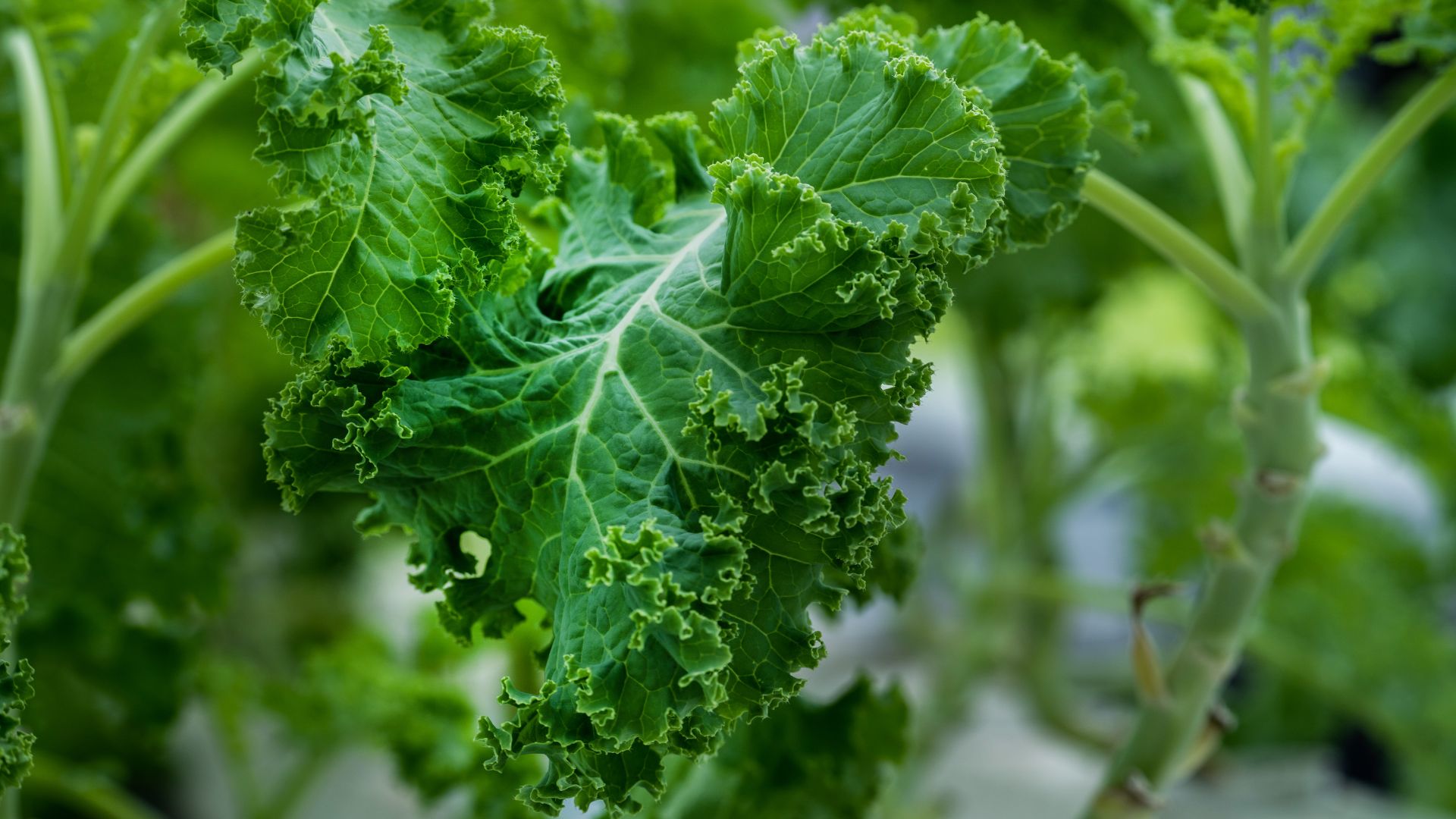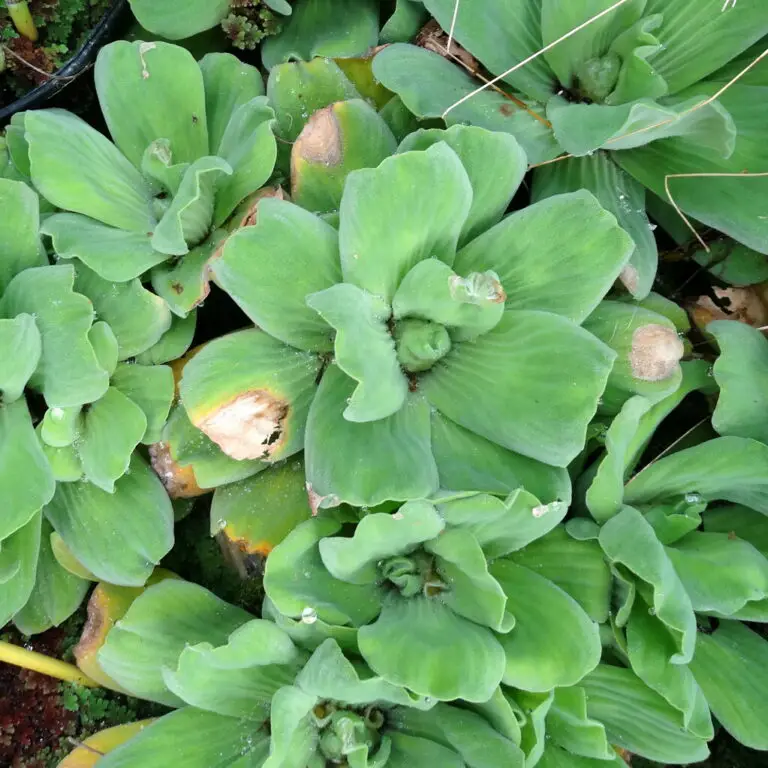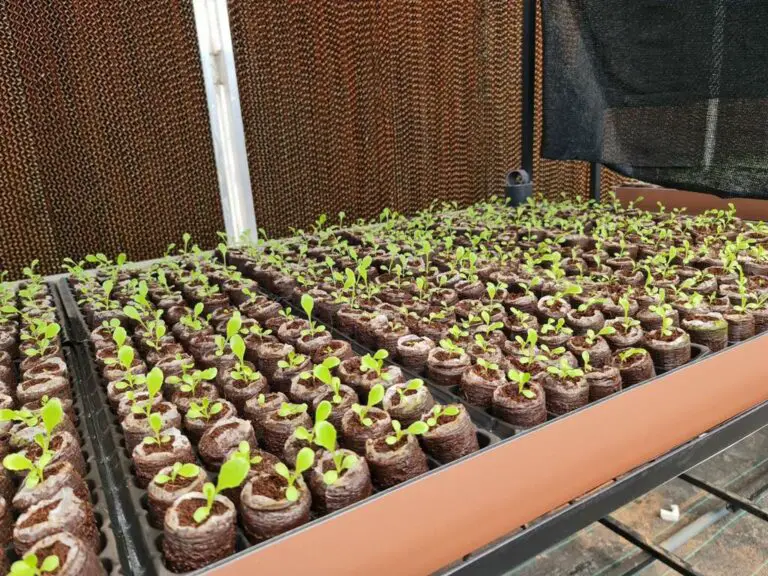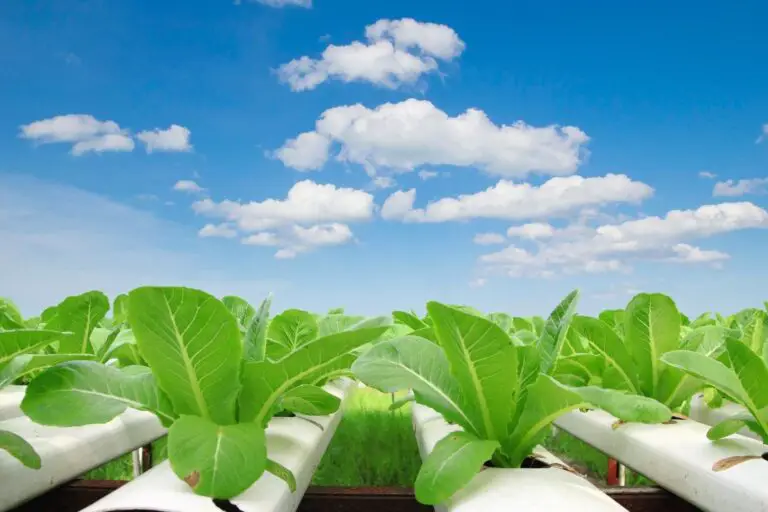13 Essential Hydroponic Nutrients for Maximum Plant Growth
Disclosure: Your purchases through our links may earn us a small commission, supporting our site’s ability to provide valuable information to our readers. Rest assured, it won’t impact your price. Thank you for your support.
One of the benefits of using a hydroponic system for growing plants is that you can closely control the nutrient levels in the water. This is important because plants need different levels of nutrients to grow properly. In a hydroponic system, you can adjust the nutrient levels to match what the plant needs at any given time.
It cannot be easy to provide the nutrients your plants need in traditional soil gardening. Nutrients become diluted and locked in the soil over time, making it impossible to replenish them completely. Additionally, some nutrients are not available in the soil or break down too quickly for plants to use them effectively. Hydroponic systems are designed to deliver specific amounts of nutrients at precise times, so plants can access them right away and use them effectively.
There are other benefits, in addition to the control that comes with using a hydroponic system. Since you don’t have to worry about soil quality or nutrient levels in the ground, you can grow plants in locations where traditional gardening is impossible. For example, you can grow plants indoors on a windowsill or in a greenhouse, even if there isn’t any soil available.
What Are the Hydroponic Nutrients Required for Plants
Knowing which nutrients are needed to grow healthy plants in a hydroponic system. Each type of plant has different requirements, but most plants need Nitrogen, Phosphorus, and Potassium as primary nutrients and secondary nutrients such as Magnesium, Calcium, and Sulfur. These nutrients are necessary for photosynthesis, respiration, and other vital processes.
In addition to the primary nutrients, some plants also require other micronutrients such as Boron, Manganese, Iron, Zinc, Chlorine, Copper, and Sodium.
These elements help to support plant growth and development by improving nutrient absorption, strengthening cell walls, regulating metabolism, and promoting other essential processes.
You can grow healthy, productive plants in a hydroponic system with the proper care by providing all the necessary nutrients for optimal growth. Ideally, you should carefully monitor the nutrient levels in your hydroponic system and adjust them as needed to ensure that your plants receive all the essential nutrients they need for optimal growth. This can involve regular testing of the nutrient solution and careful adjustments using various additives or dietary supplements.
We will look into each nutrient and its importance in plant growth.
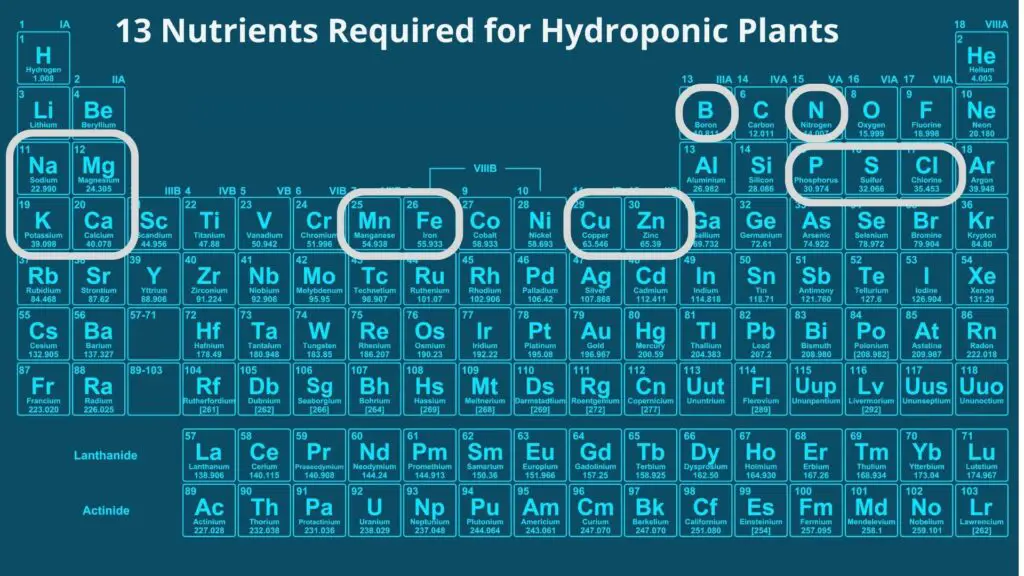
1. Nitrogen (N)
Importance of Nitrogen
Nitrogen is essential for plant growth because it helps create chlorophyll, which is critical for photosynthesis. Nitrogen is also involved in producing proteins, enzymes, and other vital compounds.
Source of Nitrogen
Nitrogen can be obtained from natural sources such as lightning strikes or biological nitrogen fixation. However, human industrial processes are also used to convert nitrogen gas into other more readily available forms for plant use.
What if there is a Nitrogen deficiency?
When plants don’t have enough nitrogen, they may become yellow or short. Yellowing and stunting are symptoms of nitrogen deficiency. Nitrogen-deficient plants also display spindly development and an etiolated habit due to a reduction in the production of amino acids and nucleic acids.
2. Phosphorus (P)
Importance of Phosphorus
Phosphorus is another essential element for plant growth. It helps create strong roots, promotes blooming and fruiting, and encourages proper cell division. Cellular metabolism through Phosphorus plays a key structural role in cell membranes, nucleic acids, and other plant tissues. Phosphorus is a limiting nutrient for plant growth, particularly in tropical regions or in highly weathered soils.
Source of Phosphorus
Phosphorus is present in most lawns and green spaces in sufficient quantities. The weathering of minerals and soils in the Earth’s crust is the ultimate terrestrial phosphorus source.
What if there is a Phosphorus deficiency?
Plants that don’t have enough Phosphorus may become stunted or produce fewer flowers and fruits. Darkening or purpling of the leaves, stunting, and necrotic lesions are all symptoms of phosphorus deficiency.
3. Potassium (K)
Importance of Potassium
Potassium is an essential element for plant growth because it helps to regulate metabolism, promote root development, and improve disease resistance. Most plants require potassium in fairly high concentrations.
Source of Potassium
Most soils contain potassium because it is derived from the weathering of rocks and minerals. It can be found in the soil naturally, although some plants have developed a stronger capacity to absorb it through the air or biological processes.
What if there is a Potassium deficiency?
Plants that don’t have enough potassium may become weak or vulnerable to pests and diseases. Symptoms of potassium insufficiency include stunted growth, necrosis, chlorosis, and disease susceptibility. The first signs of potassium deficiency are often seen in mature leaves, as the plant transfers potassium to actively growing younger tissues to promote development.
Related: NPK for Hydroponics: How It Works and Why It Matters?
4. Magnesium (Mg)
Importance of Magnesium
Magnesium is another important mineral nutrient for plant growth. It helps activate many vital enzymes and proteins, and it also plays a role in photosynthesis and chlorophyll production.
Source of Magnesium
Magnesium is mainly found in soil and rocks, although it can also be absorbed from rainfall or groundwater. Some plants can absorb magnesium directly from the air through their roots.
What if there is a Magnesium deficiency?
Magnesium deficiency will likely occur in conjunction with metal toxicity due to the increased solubility of metals at low pH. There is no single pattern of symptoms for magnesium deficiency.
When plants don’t have enough magnesium, they may become yellow or discolored in other ways. Plants that have insufficient magnesium often exhibit chlorosis. The symptoms of magnesium deficiency tend to appear first in more mature tissues because magnesium is translocating within the plant.
5. Sulfur (S)
Importance of Sulfur
Sulfur is one of the most common nutrients for plants since it’s found in most soils. It is required for healthy respiration and protein synthesis, and many other vital processes. Sulfur is a biologically ubiquitous element, playing critical structural roles in amino acids and compounds involved in electron transfers in photosynthesis and respiration. Sulfur is also a structural component of specialized enzymes and related molecules.
Source of Sulfur
Sulfur is most often encountered as sulfate in the soil, which comes from weathering parent soil materials or by-products of fossil fuel combustion, such as hydrogen sulfide and sulfur dioxide. These gases are changed to acid rain by this process.
What if there is a Sulfur deficiency?
Sulfur deficiencies can cause plants to appear yellow or stunted, and they may also produce fewer flowers or fruits. Plants lacking in sulfur often have symptoms such as chlorosis and spindly or stunted growth. Unlike plants deficient in nitrogen or potassium, sulfur-deficient plants generally exhibit symptoms in younger, developing tissues due to its limited translocation within the plant.
6. Calcium (Ca)
Importance of Calcium
Calcium is an important nutrient for plant growth because it helps build strong cell walls, promote root development, regulate metabolism, and signal transduction in plants.
Source of Calcium
Most calcium in the soil is derived from geologic sources and plays a critical role in the cation exchange mechanism.
What if there is a Calcium deficiency?
When plants don’t have enough calcium, they may be stunted or generate fewer flowers and fruits. Calcium deficiency can result in death of growing buds, young leaves, and root tips.
Calcium deficiency can also be caused by a high pH (higher acidity). Many metals become hazardous at elevated pH due to their increased mobility. As it makes the nutrient less accessible to plants in these situations, high pH (higher acidity) can also contribute to calcium insufficiency.
7. Boron (B)
Importance of Boron
The precise functions of boron in the plant are unknown. Boron is an essential micronutrient for plant growth because it helps to promote cell division, strengthen cell walls, and regulate metabolism.
Source of Boron
Boron is a micronutrient commonly found in the soil solution as boric acid.
What if there is a Boron deficiency?
When plants don’t have enough boron, they may become stunted or produce fewer flowers and fruits. Plants deficient in boron often show general brittleness of organs, and the apical meristems may die. Additionally, roots may become brittle or die. These deficiencies can make plants more susceptible to infection by pathogenic organisms.
8. Manganese (Mn)
Importance of Manganese
Manganese is an important micronutrient for plant growth because it helps to create enzymes, proteins, and other vital compounds. It also plays a role in photosynthesis and chlorophyll production.
Source of Manganese
Manganese is present in both geologic and biological sources. It’s a micronutrient element typically found in the soil solution as Manganous.
What if there is a Manganese deficiency?
The symptoms of manganese deficiency differ depending on the plant species. Plants that don’t have enough manganese become yellow or brown in various ways. Deficient plants usually have chlorotic or necrotic lesions on their leaves, fruits, or seeds. The occurrence of symptoms is dependent on the plant species.
9. Iron (Fe)
Importance of Iron
Iron is an essential micronutrient for plant growth because it helps to create enzymes, proteins, and other vital compounds. It also plays a role in photosynthesis and the transportation of nutrients throughout the plant.
Source of Iron
Iron is found in the soil as oxide and carbonates and bonded to organic compounds.
What if there is a Iron deficiency?
When plants don’t have enough iron, they may become yellow or discolored in other ways. Plants deficient in iron initially show interveinal chlorosis in the younger tissues because iron is not readily translocated within the plant body.
Plants can get the iron they need from the soil even if it has a low pH. This is because plants produce special compounds called siderophores which bind to the iron in the soil. The plant then absorbs the siderophore, along with the iron it contains. Once inside the plant, the iron is released and used by the plant.
10. Zinc (Zn)
Importance of Zinc
Zinc is another essential micronutrient for plant growth because it helps to promote enzyme and protein production, create healthy roots, and regulate metabolism. Zinc is involved in chlorophyll synthesis and the synthesis of proteins from DNA.
Source of Zinc
Zinc may be obtained from both geologic and biological deposits. The micronutrient element is found in the soil solution as soluble zinc compounds, usually organic complexes or oxides.
What if there is a Zinc deficiency?
When plants don’t have enough zinc, they may become stunted or produce fewer flowers and fruits. Zinc deficiency causes stunted growth, small leaves, and rosette formation. Zinc shortages can have a significant influence on plant development and growth.
11. Chlorine (Cl)
Importance of Chlorine
Chlorine is an important micronutrient for plant growth because it helps to regulate osmosis and water absorption. It also promotes chlorophyll production, which is essential for photosynthesis.
Source of Chlorine
Chlorine is a monovalent anion in soil derived from salts in the parent soil material and is thus primarily found in soil. It is readily accessible, but it does exist in significant quantities, making chlorine deficiency uncommon.
What if there is a Chlorine deficiency?
When plants don’t have enough Chlorine, they may become discolored or stunted.
In the laboratory, Chlorine is identified by blue-green, shiny leaves that are eventually bronze in color. Plants wilt or are severely stunted in severe circumstances and show significant chlorosis and necrosis.
12. Copper (Cu)
Importance of Copper
Copper is another important micronutrient for plant growth because it helps to activate key enzymes and proteins, promote healthy root development, and strengthen cell walls. Copper is a micronutrient heavily involved in electron transfers within the cell. Copper is a component or activator of some enzymes.
Source of Copper
Copper is a dense, heavy metal that may be found in the soil and other compounds.
What if there is a Copper deficiency?
When plants don’t have enough copper, they may become weak or susceptible to pests and disease. Copper deficiencies can manifest themselves as chlorosis or leaf rolling in plants, although this varies depending on the species. Woody types may also show blistered bark or early-stage dieback due to a lack of copper.
13. Sodium (Na)
Importance of Sodium
Sodium is an important micronutrient for plant growth because it helps to regulate osmosis and water absorption. It also promotes chlorophyll production, which is essential for photosynthesis. Sodium is a micronutrient for plants that undergo C4 or CAM photosynthesis rather than C3 photosynthesis.
Source of Sodium
Sodium is included in the cation exchange complex and thus can be found in the soil solution. The primary source of sodium in the soil solution is from the parent soil material’s salts rather than sea salt. In general, salt-tolerant species can withstand a greater rate of replacement.
What if there is a Sodium deficiency?
A deficit of sodium causes plants to photosynthesize incorrectly. Plants that don’t have enough sodium become discolored or stunted.
In Summary
As you can see, many different nutrients are essential for plant growth.
To ensure that your plants receive all the nutrients they need for optimal growth, carefully monitor the nutrient levels in your hydroponic system by testing the solution regularly and making adjustments as required using various additives or dietary supplements.
Thank you for reading!
Also, read:
Hydroponic Potatoes: A How-To Guide
How to Set Up a Deep Water Culture (DWC) Hydroponic System?
If you are looking to buy organic nutrients for your indoor or outdoor garden click this link and select the best one suited for you.

